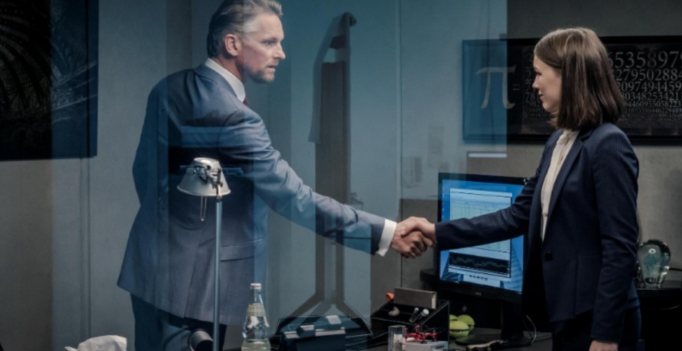Numbers aren’t my thing; I never enjoyed math in school and thinking about RRSP’s makes me want to take a nap. Yet only two episodes into creator Oliver Kienle’s financial thriller, Bad Banks, I found myself completely immersed in the twists and turns of the high-stakes world of investment banking.
Directed by Christian Schwochow, who recently became the first non-British director to be asked to direct an episode of the hit series The Crown, Bad Banks is a shining example of what makes television today so electric. From outstanding performances by a talented cast, to a tense, well-paced plot and fantastic cinematography, Bad Banks is difficult to find faults with. Patience is required, this is a character-driven show that builds momentum slowly rather than coming out of the gate at a sprint. But audiences who are willing to wait an episode or two will find that it does what all good entertainment media should: demand an emotional, psychological, and intellectual investment from its viewer.
Paula Beer (Transit, Frantz) delivers an exceptional performance as the protagonist, Jana, a young investment banker who is unfairly fired from her position at one of Luxembourg’s top banks. Beer’s Jana is a delicately crafted creation; simultaneously tough and vulnerable, she eschews most of the clichés that are usually attached to young, ambitious, female professionals. In many ways, her character is reminiscent of Jessica Chastain’s character in 2016’s Miss Sloane, another tough-as-nails lady excelling in a demanding and male-dominated profession, but Jana is more tenderly realized. I love watching representations of successful women on the big (or small) screen, but I love it even more when these women are flawed and relatable. Jana is presented both as a product of her environment – an industry that values success and results at the cost of family, relationships, and personal health – and as an individual that is intelligent enough to be critical of the system and hyperaware of its injustices and double-standards.
Bad Banks is also unapologetically female-driven. The show doesn’t shy away from facing issues of sexual abuse, discrimination, and unequal compensation head-on – but it never hesitates to show the complexities of these problems. The high-achieving female professionals in this series are the manipulators as much as they are manipulated and are just as susceptible to corruption and abusing their power as their male colleagues. The series is also upfront in its treatment of intersectionality and discrimination. Jana’s colleague Thao (Mai Duong Kieu) faces professional challenges not only because of her gender, but also as a result of her Vietnamese heritage.
The show is visually stunning. From the opening shots of riots on the streets of Frankfurt after a financial crisis, to the colour-scheme saturated in reds, yellows, and blues, there is something aesthetically interesting in almost every moment of Bad Banks. Schwochow has a keen eye for detail and symbolism that helps make for a dense, and sometimes challenging, visual experience. I finished each episode feeling as if I could watch it over again right away and peel away another layer of meaning. The episodes of the first season are so concise, each one picking up almost at the precise moment the previous one finished, that they feel almost like a single, extended film.
Only time will tell if the series, which has recently been renewed for a second season, will manage to maintain the same level of quality in the future.
The Canadian premiere of the entire first season of Bad Banks will screen at Toronto’s TIFF Bell Lightbox on October 4, 9, and 11 – presented by Goethe-Institut Toronto. Click here for more details!
**********
Do You Tweet? Follow These Tweeple:
Shannon Page: @ShannonEvePage





Leave a comment